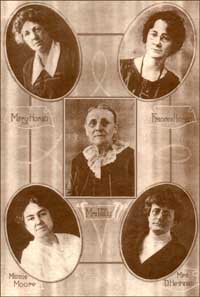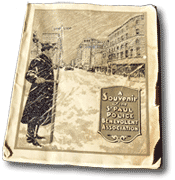In the Beginning — 4
Most of the time patrol officers and detectives had to rely on their own expertise and intuition to apprehend criminals. In the early 1900s, the few investigative tools available were in their infancy of development. The Bertillon system of identifying individuals by measuring their physical features started in France in the 1880s. By the 1900s, front and profile photographs had been added to the Bertillon system, which now was implemented in the United States.
Experiments using fingerprint identification began in the 1850s in Europe. Although it preceded the Bertillon system, a reliable classification system took years to develop. Thus, it wasn't until 1904 that New York City became the first United States police department to adopt the new fingerprint identification system, called the Henry Classification System. The classification system was incorporated into the identification function in Saint Paul in 1917.
For its time, Saint Paul's Police Department was well-equipped. Chief O'Connor proudly displayed his rogues gallery of 100,000 Bertillon cards. The mounted cards with photographs were available not only to police personnel, but they were also open to the public for viewing. Detective Edward Murnane, who reputedly had a photographic memory, could recite the statistics from hundreds of cards without error.
However, the identification and apprehension of criminals was hampered significantly by the lack of quick, reliable communications. Saint Paul had call boxes placed strategically at intersections, which enabled patrol officers to send alarms back to headquarters and substations. Telephones enabled officers to call in also, but it would be many years before technology would allow Saint Paul to receive and share information, mugshots and fingerprints with other police departments locally and across the country.
Not all was ‘well’ in the Saintly City during the early 1900’s though, for in 1905 Italian immigrants Carmine and Josephine Ruberto opened up Bucket of Blood to provide a place for Saint Paulites to gamble, drink and participate in “not so public” activities. Paul Maccabee, author of Dillinger Slept Here: A Crook’s Tour of Crime and Corruption in St. Paul, said the saloon and other nearby brothels served as a rite of passage for young men. It is suggested that the Ruberto’s had been slipping money to Chief John O’Connor to overlook their quasi-legal activities.
Putting police on the payroll was common among the era’s red-light district proprietors, including the notorious madam Nina Clifford, according to Maccabee. Nina Clifford’s and Bucket of Blood were located near each other on the site that is now the Science Museum of Minnesota. Saint Paul police headquarters at the time was just down the street, Maccabee says.
“Literally police could look out the windows and see the men going into the Bucket of Blood, Maccabee says. “There was an amicable relationship between the police and the underworld in Saint Paul.” A Ruberto descendant alleges that the police chief’s wife, Annie O’Connor, was the madam who ran the prostitute ring out of Bucket of Blood.
On June 26, 1906, the first four officers retired on a pension benefit of the police pension law. They were Officers Edward Delaney, Albert Stotz, Andrew Rose, and Louis Marian.
An unusual job termination occurred on June 1, 1907, when Officer Charles Grisim, a Rondo Substation patrolman, was dismissed upon complaint from his sergeant. Sergeant Gerber found Grisim sleeping in a tool box on his beat with an alarm clock near his head, which woke him every hour in time to pull his box.
The Motorcycle Squad was started June 15,1909, consisting of two men and their machines. This unit proved a unique advantage for the Department, as these officers easily navigated through traffic and traversed the city with speed.
With the increase of motor vehicles in the city, a Traffic Squad was commissioned on July 4, 1912. Twenty officers were assigned with an increase of pay of five dollars per month over their scheduled salary.
The motorization of the Department dates back to 1912, when a White squad wagon was acquired for $5,000.00 and a Chalmers five-passenger touring car was purchased for $2,400.00. The following year, an authorization was given to purchase an automobile ambulance. It wasn’t until 1914, however, that the Department purchased automobiles suited specifically for police work: a Velie Runabout, a White patrol car, and two Kissel police patrols.
The rank of roundsman was also created in 1912. Roundsman was similar to the rank of corporal and was a supervisor in the absence of a sergeant. Twelve men were appointed and received a salary of eighty-five dollars per month for their hard work.
John O'Connor and his assistant chief of police, John Clark, resigned just before the city elections of 1912. O’Connor tendered his resignation to the police board, claiming that his work had been thwarted and that this interference had caused a break in the splendid discipline of men in his department. Acting Chief Frederick M. Catlin, later a Ramsey County District Court Judge, became his replacement. In the following two years, three different chiefs of police were appointed, one of which was fired and then convicted on charges of receiving bribes.
 Despite the steady turnover of chiefs, there was one notable improvement.
In 1913, Saint Paul added the first policewomen to the force. At
the time, many people, especially women’s organizations, were
concerned about the welfare of the city's women and children. They
also were aware that other police departments around the country
had added women. As a result, Margaret Kelly and Minnie Moore were
appointed to the Saint Paul Police Department.
Despite the steady turnover of chiefs, there was one notable improvement.
In 1913, Saint Paul added the first policewomen to the force. At
the time, many people, especially women’s organizations, were
concerned about the welfare of the city's women and children. They
also were aware that other police departments around the country
had added women. As a result, Margaret Kelly and Minnie Moore were
appointed to the Saint Paul Police Department.
Officially, Kelly and Moore received the title of police inspector but were called policewomen. While exploring the role of women in police work, Saint Paul solicited a legal opinion in 1912. The attorney responded, “Women, while having the right to vote for school and library officers, and to hold such offices, are not legal voters as that term is used in the statutes. Women therefore are not eligible to hold public office of policeman, patrolman, or detective or any other office of a similar nature with authority to make arrests.” Even so, Kelly and Moore performed their jobs with determined professionalism. During Margaret Kelly’s first year, she chased women and children out of saloons, monitored proper behavior in dance halls and reported on scandalous movies in the new theaters. Kelly also visited area schools, hotels, factories and hospitals, always checking on the welfare of women and children. Kelly and Moore were so successful in their first year that more women were hired by the Department, paving the way for all future policewomen. Minnie Hessian was hired in 1913. Mary A. Smith also became a policewoman in those early years. The passage of the Woman Suffrage Amendment in 1920 finally enabled them to become sworn officers. Minnie Moore later went on to become the supervisor of the Policewomen Unit. Women did not serve in large numbers, however, until the 1970s.
In 1914, Saint Paul's citizens approved a change to a commission form of government. The new system allowed voters to select candidates in primary elections, rather than through political party conventions. As part of the new system, a Saint Paul Public Safety Commissioner slot was created, replacing the board of police commissioners. Commonly, Saint Paul's police would be referred to as a police department, but under the new system it was officially known as the Bureau of Police. Election processes may have changed in 1914, yet one thing remained the same: the chief of police was still appointed. As in past years, a new political regime resulted in the appointment of a new chief and John O'Connor was again designated.
 According to a 1919 history of the Police Department, O'Connor cleaned
house, accepting the resignations of sixteen members of the Department.
Experienced detectives and officers returned.
According to a 1919 history of the Police Department, O'Connor cleaned
house, accepting the resignations of sixteen members of the Department.
Experienced detectives and officers returned.
“So once more Saint Paul became the nightmare of crooks. Known crooks who are not being searched for by departments in other cities come to Saint Paul occasionally, tarry a while, and beat it to other climes. Their presence and identity is known as soon as they appear on the streets, and they fear the consequences if they 'turn a trick' in Saint Paul... the life and limb of the St. Paul resident is secure, and peace reigns supreme in the Saintly City.”
If peace existed, it was only temporary. By 1914, Europe was at war. In Saint Paul, police dealt with a variety of public displays and disturbances. Woman suffrage groups staged rallies in Rice Park. Unruly drunken crowds caused the city to suspend the annual St. Patrick's Day parade. In October, 1917, streetcar motormen went on strike. According to newspaper accounts, thousands rioted in Saint Paul's streets, stoning motormen and smashing streetcar windows. Chief O'Connor ordered thirty officers on suburban streetcars for protection. Eleven men were arrested.
In 1918, the influenza epidemic hit Saint Paul. People were urged to stay home in an attempt to prevent spread of the disease. In spite of this, when the armistice was signed, police had to subdue crowds that celebrated in the streets.

